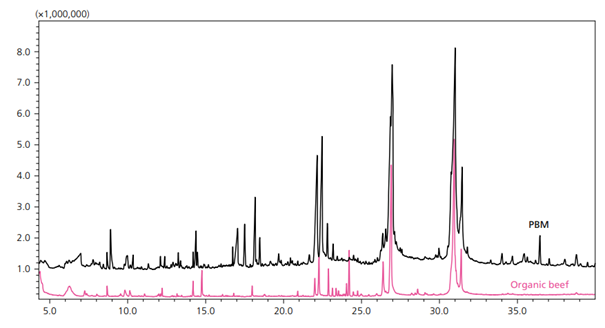
Panel discussion on...
Healthy lifestyle
Welcome in the world of alternative meat: analytical challenges and perspectives

Introduction
1) In the past year, consumer attitudes towards health have shifted towards products that are clinically effective rather than just labeled as natural. There is a growing awareness of how lifestyle factors, particularly mental well-being, stress, and emotions, influence long-term health. Recent data from FMCG Gurus (1) highlights a global trend towards prioritizing mental health, with 62% of consumers aiming to improve it in the next year. Mental well-being is now viewed on par with physical health by 4 in 5 consumers, emphasizing the importance of holistic wellness. Additionally, fitness apps, online classes, and wearables serve as popular tools for health monitoring and personalized insights to gradually optimize overall wellness.
2) In the last year, nutritional science has made significant progress in understanding the interplay between diet, the human gut microbiome and nutrigenomics, especially with the integration of AI and machine learning. The DIRECT PLUS randomized controlled trial is a significant scientific achievement that represents the synergy of these advances. It examined the effect of polyphenols on biological aging, assessed through DNA methylation. The study, published in 2023 (2) found a strong association between a Mediterranean diet, high in polyphenols and low in red or processed meat, and the slowing of biological ageing. The study also found that lower methylation aging was associated with higher levels of urinary urolithins and tyrosols. These phenolic compounds are abundant in foods such as walnuts, pomegranates, olives, and olive oil, strengthening the link between Mediterranean diet, dietary polyphenols and biological age attenuation.
3) Mental well-being research has expanded, exploring the relationship between gut microbiome changes and mental health. Aging and longevity research is also seeking ways to extend health and lifespan through lifestyle, diet changes, and enhancing beauty from within. Moreover, clinical research on key areas crucial for addressing global health challenges has intensified, with a rise in studies on diabetes, immunity, cardiovascular, and metabolic health, highlighting the significance of dietary patterns in managing these conditions. One recent focus is on GLP-1 receptor agonists, primarily for managing type 2 diabetes and promoting weight loss. A recent review in BMJ (3) highlighted their effectiveness in managing blood sugar, reducing weight, and improving lipid profiles. A study from the University of California, Irvine, showed a significant increase in the use of GLP-1 receptor agonists for weight loss in the California healthcare system (4). This trend is expected to continue as evidence of their efficacy grows and researchers are exploring plant-derived compounds like berberine and urolithins as potential GLP-1 modulators, with ongoing trials assessing their role in conditions including diabetes and dyslipidemia.
4) Consumers prioritize scientifically backed products with transparent sourcing. Peer reviews, social media, and influencers shape preferences, emphasizing the quest for credible and engaging content. As an ingredients supplier, providing comprehensive, clear data on clinical research, efficacy, bioavailability, and sourcing is vital in B2B. This supports informed decisions, aligning product development with consumer demands for authenticity and effectiveness.
5) How do consumer today judge their health status:
Please put the following parameter in order. 1 highest priority 7 lowest priority
- Mental and Emotional Well-being: stress levels, emotional balance, happiness
- Quality of sleep: Sleep quality and duration
- Health Tracking Devices and heart rate, sleep patterns, steps taken
- Diet and Nutrition: intake of fruits, vegetables, whole grains, proteins.
- Fitness Levels: endurance, strength, flexibility,
- Medical Check-ups: blood pressure checks, cholesterol screenings, blood sugar tests
- Physical Symptoms, like pain, fatigue, constipation, weight gain
6) Do you see a trend to carry out ingredient clinical trials using a selected delivery format as study product formulation or are most clinical studies still done in capsules?
Consumer preferences are shifting towards innovative delivery formats, such as gummies, effervescent tablets, functional beverages, liposomal formulations, and nanoemulsions. These formats are preferred due to their convenience, enhanced flavor, and improved bioavailability. Regional differences also play a role, with jelly sticks being favored in Asia and capsules and tablets being preferred in the West. Traditional and liquid herbal extracts are becoming more popular through herbal teas and tinctures. Capsules are still preferred in clinical trials due to their dosing accuracy, stability and ease of blinding.
8) While there is some overlap between lifestyle apps and supplement brands, the former tends to complement rather than compete with the latter due to their focus on personalized health insights. Although they indirectly compete by offering personalized solutions, these apps can also educate consumers, enabling them to make more targeted and informed decisions when seeking supplements. This synergy can optimize consumer engagement and product selection by bridging digital health management and nutritional supplements through the connection of digital health platforms and supplement brands.
9) We are evaluating technologies like bioinformatics, AI, and decentralized clinical trials to advance our research of health ingredients. In-silico studies, using extensive botanical libraries, are integral to modern research and development process. By applying machine learning and AI methodologies, researchers can gain new insights into the health benefits of botanical compounds, expediting discovery and enhancing comprehension of mechanisms. This approach enables to predict efficacy and safety, reducing the risk of late-stage failures. Despite challenges like ethical concerns and regulatory guidance, AI has the potential to expedite clinical research and increase success rates, offering significant benefits.
10) Consumers worldwide now expect nutraceutical brands to demonstrate genuine commitment to sustainability by reducing their environmental impact, while maintaining transparency. At Euromed, this involves implementing a circular economy model and converting waste from plant extraction into socially useful products such as natural-based dyes and animal feed. We prioritize renewable energy, water conservation, and ethical practices. Our core values include inclusivity, diversity, and customer satisfaction. We adhere to Good Agricultural and Collection Practices (GACP) to preserve biodiversity and expand our range of organic extracts. In addition, we prioritize eco-friendly extraction technologies and locally sourced raw materials to reduce transportation carbon footprint and simplify our supply chain.
11) According to McKinsey’s latest Future of Wellness research (5), healthy lifestyle trends vary worldwide due to cultural, environmental, and accessibility factors. In the UK and US, there's a growing preference for wellness products with clinically proven ingredients, while in China, consumers equally value clinical effectiveness and natural ingredients. Doctor recommendations strongly influence consumer health purchases, especially in the US, where weight management and sexual health are important concerns. Globally, there is a significant demand for gut health products and a growing focus on mental well-being, but Europeans over 30 view their health more negatively, possibly due to the burden of an ageing population. Skincare routines in Asia focus on hydration, brightening, and anti-aging, reflecting preferences for fair skin and sun protection.
11a) China's health food regulations have implemented a dual-track system since March 2021. Domestic health food products with specific ingredients can now be filed instead of registered, while imported products still require registration. The market trend leans towards clean labels, informative claims, and influences from traditional medicine. Popular product forms include capsules, functional drinks, and gummies. The Punk Health Movement, popular among younger generations, blends health with indulgence, emphasizing elements like sleep, skincare, and moderate alcohol consumption.
11b) The US market shows a preference for claims related to immunity, mental health, and personalized nutrition. There is a growing demand for products with clean labels, natural ingredients, and seamless digital experiences. Capsules, tablets, and drinks are popular product forms, while gummies are particularly favored by younger consumers. In December 2022, the FTC updated its Health Products Compliance Guidance, marking the first significant change in over 25 years. This update clarifies coordination with the FDA and stresses the importance of reliable scientific evidence for health claims. It is worth noting that the Punk Health movement has gained traction in the US, emphasising individual empowerment and the balance between autonomy and evidence-based practice.
11c) In Mexico, functional foods and supplements often make claims related to energy, weight management and metabolism, reflecting widespread concerns about diabetes and obesity. In addition, traditional herbal remedies strongly influence product development, with an emphasis on natural and familiar ingredients. Popular product forms include tablets, capsules and functional drinks.
11d) The European market values health products that prioritize enhancing the immune system and gut health, as well as being eco-friendly. While the EU has strict regulations on health claims, Euromed navigates successfully by prioritising science-based claims and compliance. We optimise traditional herbal medicinal product (THMP) registrations, proactively address compliance and growth, and ensure product integrity through advanced analytical technologies. We are based in Spain and are in compliance with strict EU laws and certifications. Our focus is on effective B2B marketing with an emphasis on traditional uses and scientific research.
12) Our current target are middle-aged males and females interested in sports nutrition. We have introduced spinach (Spinacia oleracea L.) and cucumber (Cucumis sativus L.) extracts to our Mediterranean line, inspired by the holistic and healthy aging properties of the Mediterranean diet. A study conducted on 45 healthy males and females aged 50 and above showed that our spinach extract, when combined with resistance training, led to significant improvements in muscle strength and quality compared to the placebo group (6). Spinach's high phytoecdysteroid content provides various health benefits, including enhanced physical performance and stress resistance, which are critical to healthy aging.
Cucumber extract is gaining attention for its potential anti-inflammatory properties and ability to promote joint health and recovery, particularly among middle-aged athletes and fitness enthusiasts. A study of 55 subjects over the age of 40 with knee pain showed significant reductions in subjective and objective measures of pain and stiffness, with improvements in physical and muscle function and lowered inflammatory biomarkers over an 8-week period (7). The extract includes standardized L-citrulline, which may help with pain relief, function, and reducing inflammation. Both studies analysed the safety and tolerability of our extracts and found no adverse effects, with good tolerability.
What is required to scale-up production of alternative protein sources, such as lab-grown meat and cultivated (breast/bovine) milk?
For the production of 1 kg meat approx. 1 thousand times more water is needed than for 1 kg grain. And furthermore 60% of grain production in Germany is used for feeding cattle and pork.
The development of automated production equipment for tailor-made cultured meat using 3D bioprinting will help to feed the world (4).
The 3D bioprinting technology was developed by Professor Matsusaki of the Osaka University to create muscle tissue structures. This technology is expected to be utilized in the field of food, for production of cultured meat with controlled arrangement of muscle, fat, and blood vessels.
Most of the cultured meats reported so far have a minced structure consisting only of muscle cells, making it difficult to reproduce complex structures. To solve this problem, Matsusaki and co-workers developed a 3D bioprinting technology that uses 3D printing to produce different fibrous tissues (muscle, fat, and blood vessels) and integrates them into a bundle. This technology has made it possible not only to reproduce the famous Wagyu beef, but also to delicately adjust the fat and muscle components. Osaka University and Shimadzu will jointly develop equipment to automate the production of cultured meat using this technology. (5).
What are the most effective methods for enhancing the flavor and texture of alternative proteins?There are meaningful reasons not to go for these new types of foods
Bad experience in terms of taste and texture
Raw meat on its own has little aroma; therefore, almost all aromas associated with “meatiness” are created during the cooking process by the Maillard Reaction between amino acids and reducing sugars. That reaction determines which non-volatile precursors release volatile aroma compounds. Plant-based meat (PBM), products created to resemble animal meat in both look and taste, are growing in popularity. A plant protein such as soy protein concentrate, along with colors, stabilizers, and oils, is used to successfully mimic meat flavor and texture. And, just like in animal meat, the amino acids of that protein undergo the Maillard Reaction.
Samples of PBM were run with the solid phase microextraction GC-MS and the volatile profile was compared against that of the organic beef. Similar compounds, such as fatty acids and Maillard browning reaction products, were found in both types of meat (Figure 1).
The differences can be explained by the different and wide variety of precursors present in PBM since it contains amino acids and sugars from various sources as opposed to regular meat.
There are five basic tastes, including deliciousness, which are perceived by people. The amount and kind of amino acids contribute to taste components. Of all the amino acids, glutamic acid is widely known as a component of the delicious taste. Further, the types and component ratios of amino acids largely control the flavor of food products. For example, glycine and alanine are associated with sweetness, valine and leucine with bitterness, and aspartic acid and glutamic acid with deliciousness.
The texture of food, including the sense of crispness, springiness, firmness, and the feeling on the tongue, is an important element that together with taste has an impact on the deliciousness of food. Food texture is normally evaluated using sensory tests. However, sensory tests are often difficult to reproduce, due to individual differences in people’s sensations and physical condition.
A texture analyzer can support sensory test with objective results in the form of numerical values for use in the field of food development. The texture analyzer evaluates the texture characteristics and allows a comparison of the texture of plant-based meat (PBM) and, for instance, chicken meatballs. Compared to chicken-derived products, plant-based meatballs had a higher force under loading conditions with less elasticity, which is the property to restore deformation (6). It is consistent with the result of the sensory test.

Figure 1. Overlaid Representative Chromatograms for PBM (black) and Organic Beef (pink) (6).
Panelists
References and notes
- FMCG Gurus – How to Help Consumers Stick to their Health Goals – Addressing Barriers to Healthy Living – Global Report – 2024 https://fmcggurus.com/reports/fmcg-gurus-how-to-help-consumers-stick-to-their-health-goals-addressing-barriers-to-healthy-living-global-report-2024/
- Yaskolka Meir et al. BMC Medicine (2023)21:364.https://doi.org/10.1186/s12916-023-03067-3
- Yao H, et al. Comparative effectiveness of GLP-1 receptor agonists on glycaemic control, body weight, and lipid profile for type 2 diabetes: systematic review and network meta-analysis BMJ 2024; 384 :e076410 https://doi.org/10.1136/bmj-2023-076410
- Watanabe JH, et al. Trends in glucagon-like peptide 1 receptor agonist use, 2014 to 2022. J Am Pharm Assoc (2003). 2024 Jan-Feb;64(1):133-138. https://doi.org/10.1016/j.japh.2023.10.002
- https://www.mckinsey.com/industries/consumer-packaged-goods/our-insights/feeling-good-the-future-of-the-1-5-trillion-wellness-market
- Pérez-Piñero, S.et al. A 12-Week Randomized Double-Blind Placebo-Controlled Clinical Trial, Evaluating the Effect of Supplementation with a Spinach Extract on Skeletal Muscle Fitness in Adults Older Than 50 Years of Age. Nutrients2021, 13, 4373. https://doi.org/10.3390/nu13124373
- Pérez-Piñero, S. Effectiveness of a Cucumber Extract Supplement on Articular Pain in Patients with Knee Osteoarthritis: A Randomized Double-Blind Controlled Clinical Trial https://www.mdpi.com/2076-3417/13/1/485
Questions
1.
2.
3.
4.
5.
How have consumer awareness & demands related to healthy lifestyle changed in the last 12 months?
Where do you see the greatest scientific achievement in nutritional sciences in the last 12 months?
Are there specific health benefit areas in which significant more clinical studies are being done than in others, comparing the last 3 years?
What are the key influencers driving consumer purchasing decision for supplements or health foods? Is substantiation of claims important?
How do consumer today judge their health status?
Please put the following parameter in order 1 highest priority 7 lowest priority:
- Physical Symptoms, like pain, fatigue, constipation, weight gain
- Fitness Levels: endurance, strength, flexibility,
- Health Tracking Devices and heart rate, sleep patterns, steps taken
- Diet and Nutrition: intake of fruits, vegetables, whole grains, proteins.
- Mental and Emotional Well-being: stress levels, emotional balance, happiness
- Quality of sleep: Sleep quality and duration
- Medical Check-ups: blood pressure checks, cholesterol screenings, blood sugar tests
6.
Delivery formats can support consumer compliance and underline the technology driven approach of the brand.
a.
b.
c.
Do you see a consumer trend in preferences for certain delivery formats?
Are delivery format preference a regional, cultural aspect like taste?
Do you see a trend to carry out ingredient clinical trials using a selected delivery format as study product formulation or are most clinical studies still done in capsules?
7.
Consumer health concerns can vary widely across different regions and demographics globally. However, several common health concerns tend to be prevalent across various countries and populations due to globalization, lifestyle changes, environmental factors, and access to information.
a.
b.
Which are the key global consumer health concerns?
Do you see regional differences?
8.
There is a significant increase in the availability of apps and digital platforms focused on healthy lifestyle, particularly to support personalized approaches to mental wellbeing, metabolic support, weight management and physical fitness.
a.
b.
c.
d.
Do you see lifestyle apps as competition for supplement brands?
Do you think that these apps help to educate consumers, being more targeted when searching for supplements?
Did you consider setting up a lifestyle app to promote your supplement or your ingredient?
Did you set up a lifestyle app to promote your supplement/ ingredient and can you explore about your experience and business impact?
9.
AI (Artificial Intelligence) algorithms are today offered for various aspects of clinical trials to proof efficacy of your health ingredient or supplement.
a.
b.
c.
d.
Are consumers looking for substantiation of claims through AI driven clinical trials?
Did you consider working with an CRO specialist in AI to investigate your health ingredient or supplement?
If you applied already AI methods during the discovers/ development of your health ingredient, please share your experience and recommendation with us.
Do you think that in 2030 AI will be a manifest tool for clinical trials?
10.
A healthy lifestyle may also involve a commitment to sustainable practices for both personal and planetary health. This could include supporting ethical and environmentally conscious products.
a.
b.
c.
d.
e.
Do you agree that sustainability has become a growing concern also in the nutraceutical industry?
Are consumer looking proactively for brands which have ethical and environmental principles?
Are you looking for ethically sourced raw materials, ingredients?
Did you implement measures to establish resource-efficient processes?
Are you developing socially useful products and how do you define it?
11.
What are the major geographical differences related to healthy lifestyle trends?
a.
b.
c.
d.
e.
What are the latest trends related to claims and product forms in China?
In the U.S.
In Mexico
How are claims and dosage forms differentiated in Europe? How does your company ensure compliance with health and safety regulations in Europe?
Do you have a country where you would like to speak about trends for products?
12.
Focus clinical studies. Overall, there has been a recognized push for more gender-inclusive, geographical, and target group focused clinical research. The same trend can be seen in clinical trials for supplements or functional foods.
a.
b.
c.
d.
Please select an area you are active in and let us know which is your hot topic ingredients for 2024 for this area, based on substantiated claim, parameters, biomarkers being studied and/ or clinical study being done. Please name ingredients by scientific name and composition and not by brand name.
Please select your geographical area:
Western (EU, USA)
Asia (China, Japan, Asia Pacific)
Americas (Middle and Latin America)
Kids development/ early life nutrition/infant in Western countries and AP
Adult nutrition and prevention of developing disease
Elderly nutrition and how to support quality of life during aging
Sports nutrition, within different life decades and activity levels
References and notes























